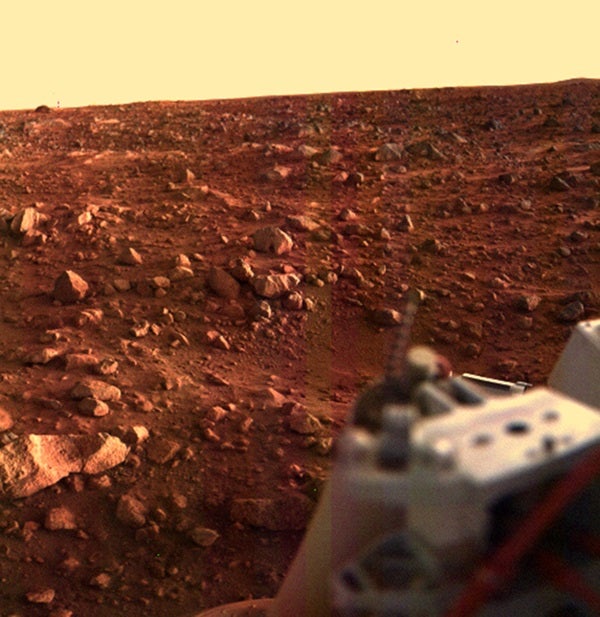Existing microbial life on Mars is a probability that should be seriously considered, according to a new paper in the journal Astrobiology. The paper sets out the argument for a biological explanation for the results of the 1976 Viking experiments of Martian soil, argues for further life tests on future missions, and evaluates the “nonbiological hypotheses” to explain the Viking results.
Forty years after the Viking spacecraft landed on Mars, people are still arguing about the how to interpret the results of Viking’s labeled release (LR) experiment. Vikings 1 and 2 landed on Mars on July 20 and September 3, 1976, respectively. Both Viking landers performed tests of the Martian “regolith,” the loose material of sand and dust on the surface.
The Viking LR experiment inserted a solution of nutrients into a sample of Martian soil and detected gases given off by the soil. Gilbert V. Levin, who was the lead experimenter for the Viking LR test and is now an adjunct professor at Arizona State University, hypothesized that microorganisms in the soil ingested the nutrients and excreted carbon-containing gases in a similar way to microorganisms on Earth.
The nutrients included a variety of organic compounds tagged with radioactive carbon-14. The gas subsequently “evolved” from the soil and made its way through a swan-neck tube to ensure that what was collected in the detection chamber was gas expelled from the soil and nothing else.
Various nonbiological explanations have been posited for the Viking LR results. Levin and Straat attempt to knock down each of those nonbiological explanations. Part of Levin’s argument is that the nonbiological explanations could account for the gas evolved from the Martian regolith, but cannot account for the lack of carbon gas evolving after the regolith had been heated to 160 degrees Celsius to sterilize it or even stored in a dark box.
“It’s hard to imagine a chemical oxidant that behaves like that,” says Levin. “We were never able to find one after three years of testing. This inactivation seems more like the death of microorganisms from lack of food or isolation from, or continual subjection to, some parameter of the environment.”
“At the time, we were looking for the types of organisms that we understood to exist at the time,” says Boston. “But now we know that there are many, many organisms in nature all through the crust of Earth’s terrestrial and ocean systems that get by without organic material at all in terms of nutrients.”
Boston studies microbial life beneath the surface of Earth and ponders what might live beneath the surface of Mars or the icy moons in our solar system. She thinks it is still possible for Mars to harbor life but thinks it is very unlikely to find that life at or near the surface of the planet.
“We need ways of getting beneath that very harsh set of conditions on the surface into the subsurface so we can begin to look for areas beneath the surface of the crust where there may still be residual life,” Boston says. In order to do that, we need to come to grips with a higher degree of planetary protection. “It’s not as if we’re not doing any planetary protection. The issue is for Mars that we currently have to face doing planetary protection at a much higher degree of stringency if we’re going to go to some of the juiciest sites, that is the places where we think are the most likely to potentially show evidence of extant life.”
One thing Levin and Boston agree on is the need to preserve the Earthly and Martian environments. Levin is in favor of returning a sample of Martian matter but thinks it should not be returned to Earth. He thinks the sample should be taken to the moon or to an orbiting space station to prevent the release of potential pathogens into the Earth environment.
Allen Zeyher is a freelance writer in the Chicago area.
Source: Discover
Source: NASA
Source: ESA











